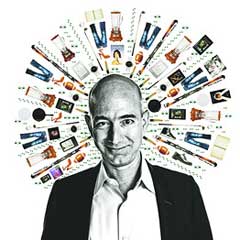Amazon Logistics Attacks by Land, Sea and Air
The Amazon Logistics Army's assault by land, sea and air is something so colossal it is hard to comprehend.
As most regular SCDigest readers will know, we follow Amazon in detail, including our popular "Walmart versus Amazon by the Numbers" columns each year.
| GILMORE SAYS: |
WHAT DO YOU SAY?'
It's the height of irony that Walmart itself went from small town store chain to the largest company in the world by focusing on logistics as much or more than merchandising.
Send us your
Feedback here
|
But a news item last week caused me to take updated look at Amazon's logistics strategies and investments, and frankly it boggled my mind.
Amazon is adding a new layer of facilities that feed its fulfillment centers (FCs) that in turn increasingly support delivery stations used by its own parcel shipment network.
It is testing a new service for users of its Fulfilment by Amazon (FBA) program, which acts as a third party for fulfillment and shipping services for companies on its Marketplace platform. Marketplace sellers can either perform or arrange their own order fulfillment - or use FBA.
These new facilities will feed fulfilment centers "from upstream, for more seamless replenishment," Amazon says.
At least for some percent of SKUs Amazon is handling for its Marketplace clients, these new facilities appear to replace vendor shipments direct to FCs, sending goods instead to these new sites, which presumably are close by FCs, likely less than an eight hour drive and often closer.
"These new facilities are essentially for inventory staging," said Rick Watson, founder and CEO of RMW Commerce Consulting, told The Loadstar.com, adding that "Amazon wants to optimize them for holding inventory."
Amazon itself has told FBA customers that "Our system will automatically replenish inventory from upstream storage into Prime-ready fulfilment centers."
Are you familiar with the concept of "forward reserve" inside a distribution center? Greatly simplified, it involves staging a small amount of inventory for generally fast moving SKUs close to (above) forward pick locations. The strategy requires an extra touch - but allows rapid replenishment when those forward pick locations are running low, minimizing time spend waiting for replenishments from traditional reserve inventory to arrive.
With this maybe new to market type of facility, Amazon is creating a "forward reserve" at the network level, adding another touch of the inventory, but with the advantage of speed.
Amazon will charge its Marketplace customers for the service, but says storage charges will be between 47% and 63% lower than it charges currently for FC storage. This would seem to enable sellers to move some storage from more expensive FC storage to these new lower cost inventory staging sites - and afford more local inventory levels.
So as Amazon creates this new type of logistics building, it triggered me to take a fresh look at just how many FCs and other types of building Amazon operates now.
According to consulting firm MWPVL and my friend Marc Wulfraat, which has tracked Amazon facility growth by type for many years, the company currently has a staggering 938 current US facilities, including 264 fulfillment centers, 361 delivery stations for normal goods, 93 more for heavy/bulky items, and 68 postal sort centers. Amazon has another 863 logistics facilities outside the US.
And more astonishingly, the pace of the site rollout is accelerating, not slowing. That's really the news here. The number of Amazon US logistics sites is not far from doubling since the start of the pandemic, with some 450 new buildings. How is that even physically possible?
As we reported a couple of months ago, Amazon now has at least 57 logistics sites open or under construction just in the greater Philadelphia market alone.
By the end of the year, Amazon will also have opened about 30 sites with a new concept, called fulfillment-and-delivery centers, which can both ship and sort parcels and are big enough to store up to three million SKUs. Amazon is on planning to open 150 of the centers in the next few years, Wulfraat says.
Despite many years of denials about its parcel intentions, earlier this week Dave Clark, CEO of Amazon's worldwide consumer business, said Monday that the company is likely to become the largest US package delivery service by as early as the end of this year.
"I think we'll probably be the largest package delivery carrier in the US by the time we get to the end of the year, if not in early '22," Clark said in an interview with CNBC.
Can that really be true? It only goes to show the enormous scale of Amazon, as it would have only reached that parity from its own ecommerce deliveries, with none of the B2B volume that historically drove UPS and FedEx's business.
 Amazon has also helped its vendors relative to the long delays and soarin costs in ocean shipping. One supplier says Amazon recently charged just $4,000 to ship a container from China to the US on one of ships it had chartered, versus about $12,000 offered by other freight forwarders. Amazon has also helped its vendors relative to the long delays and soarin costs in ocean shipping. One supplier says Amazon recently charged just $4,000 to ship a container from China to the US on one of ships it had chartered, versus about $12,000 offered by other freight forwarders.
"If the company succeeds in meeting its delivery promises to customers this year, that will be thanks to Amazon-chartered ships taking products from factories in Asia, Amazon Air cargo jets crisscrossing the US, Amazon-branded vans departing from hundreds of local delivery depots and the hundreds of thousands of employees and contractors at each step along the way," Transport Topics wrote last week.
Add in to all the above the fact that Amazon is enticing fulfillment workers with $18+ per hour wages and signing bonuses of up to $3000. It is also reportedly willing to move trucks that are only half full to get goods to FCs.
Some pundits are saying the total extra logistics costs will be around $4 billion in Q4, wiping out the company's profits in the quarter. Will shareholders care?
It's the height of irony that Walmart itself went from small town store chain to the largest company in the world by focusing on logistics as much or more than merchandising, including leading the charge in practices such as Continuous Replenishment.
Now, starting ecommerce late, Walmart hopes its mighty network of nearly 5000 US retail stores can act as ecommerce hubs for delivery, customer pick-up and more and give it advantage over Amazon.
We'll see on that. Amazon has what can only be termed weaponized logistics to likely take the crown away from Walmart - and leave so many others by the side of the road.
What's your take on Amazon's logistics assault? Let us know your thoughts at the Feedback button or section below. |








 Amazon has also helped its vendors relative to the long delays and soarin costs in ocean shipping. One supplier says Amazon recently charged just $4,000 to ship a container from China to the US on one of ships it had chartered, versus about $12,000 offered by other freight forwarders.
Amazon has also helped its vendors relative to the long delays and soarin costs in ocean shipping. One supplier says Amazon recently charged just $4,000 to ship a container from China to the US on one of ships it had chartered, versus about $12,000 offered by other freight forwarders.


